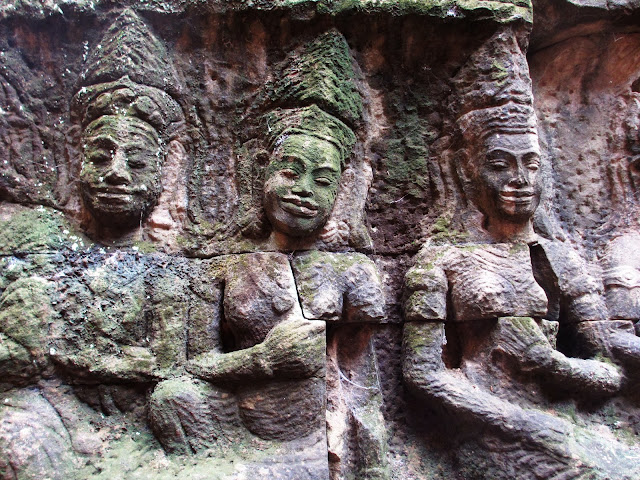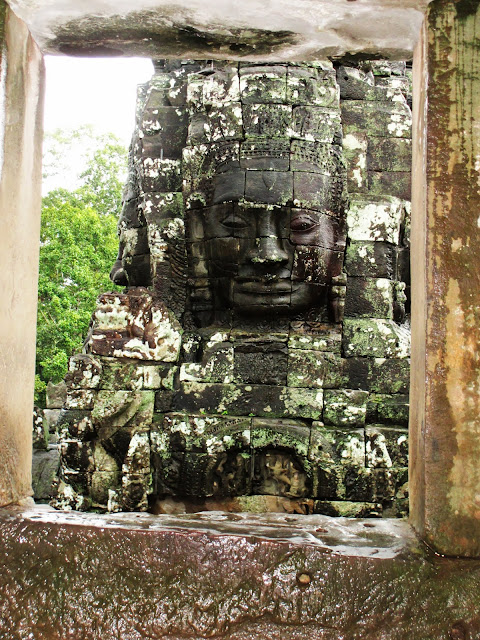Angkor Thom is enormous. It's not a temple, but actually a whole city! It's 9 square kilometers, or 3.5 square miles, and encompassed by an 8-meter (26 feet) tall wall. There's a lot of ruins inside the city, including temples, gopuras (entrance structures), terraces, palaces, and more.
 |
| Angkor Thom is the big walled area on the left. |
I've already talked about
Bayon, which is smack dab in the center of Angkor Thom. The map below is a close-up of central Angkor Thom, where all the good stuff is. Bayon is at the bottom of this map.
BAPHUON
The temple just north and to the west of Bayon is called Baphuon. It was built in the 11th century, but thanks to time and an unsteady sand base, much of the temple collapsed by the time anyone rediscovered it. Restoration efforts began in 1960 but were disrupted by the civil war, but a second attempt in 1995 was more successful. Restoration was finally completed in 2011, and visitors were finally able to see the temple in (some of) its former glory.
The first time we visited Baphuon was just after visiting Bayon, and the temple was unfortunately closed for the day. We were able to check out the outside of the temple and the walkway up to it, though.
 |
| Impressive! |
 |
| Me and my purple plastic bag raincoat. |
 |
| Love the lighting with the rain! |
The walkway up to Baphuon is pretty cool. The whole walkway is lifted up on pillars.
 |
| It's a good six feet off the ground, hence the steps. |
 |
| Viewed from the sides. |
 |
| Checking out the exterior wall. |
This is a gopura, an entrance building. It's pretty big, right? (Yes, that's me in the doorway.)
 |
| The windows have been concreted up for support. |
We went back a few days later--that's the beauty of a 7-day stay--and climbed up to the top. Cambodians must have itty bitty barbie feet because the steps are about a third of the width of my foot. Combine that with the rain and it was downright scary.
 |
| The walkway and entrance, viewed from the top of Baphuon. |
I'm not
afraid of heights, but I do have a healthy fear of death by splattering. So the complete lack of guardrails, ropes, or any other safety equipment made me a mite nervous.
 |
| That is a long way down. |
Fortunately I found ONE spot with a rope. Phew.
 |
Wearing my $2 night market shirt and $4 Cambodian Tourist Pants.
They're both shockingly comfortable! |
Baphuon is tall, but from the front it doesn't look significantly different or more special than some of the other temples. Go to the back, however, and you'll see something pretty weird.
 |
| Is that wall... round? |
 |
| Turn your head and it kinda looks like a face, right? I see a nose, an eyes, and a forehead... |
It's a reclining Buddha! The temple was originally Hindu, but it was converted to a Buddhist temple in the 15th century. The Buddha is 70 meters (230 feet) long and 9 meters (30 feet) tall.
 |
| Napping Buddha. |
Next to Baphuon is Phimeanakas and the Royal Palace area. The Royal Palace is gone, but Phimeanakas is still standing tall.
PHIMEANAKAS
Phimeanakas means "celestial temple" in Khmer and it was built in the 10th century. There's a legend that the top tier of the temple was inhabited by a naga (snake) princess, and the king had to climb up each night to "lie" with her, or else something dreadful would happen to his kingdom. That's a lot of stairs to climb every night!
Last but not least is the terrace. In front of Phimeanakas is a long decorative terrace. There are two parts to the terrace. The main part is called the Terrace of the Elephants, named because it has some pretty cool three-headed elephant carvings. To the north is the smaller Terrace of the Leper King.
The Terrace of the Elephant King was used by the king to view his returning armies, assuming they were victorious. It was also a place for him to address the people. It was part of the Phimeanakas complex at one point, but most of the materials used to build the area were organic and have long since rotted away.
 |
| The titular elephants. |
 |
| A crab! |
 |
| This is a lotus statue. It's the size of a large hot tub. |
 |
| More elephants. There's a few trios along the terrace front. |
 |
| That is a very large five-headed horse. |
 |
| Still in remarkably good shape! |
 |
| Another elephant. These carvings are probably life-size for a small elephant. |
 |
| The view from the top of the Terrace of the Elephants. |
Across the road from the Terrace of the Elephants is a group of structures called Prasats Suor Prat, which means "towers of the tight-rope dancers." It's said that during certain festivals, wires were put up between the buildings for acrobats to perform on.
 |
| These things are about 50 feet tall. The doors are normal-sized. |
That probably wasn't their original purpose, though. Some records say that they were used to pass 'divine judgement' on arguments. If two people needed to settle a dispute, they would each stay in one of the towers for three or four days. A family member would stand guard to make sure they didn't leave. The person who showed signs of illness was deemed the wrong party, and the person in perfect health won the dispute.
 |
| There are twelve towers, all in a row. |
 |
| It's clear that they've been renovated with concrete; see the color difference and the tin roof on one? |
 |
| Renovated or not, I still wouldn't want to spend three days in one of those. |
Back to the terrace. The Terrace of the Leper King is a U-shaped structure. There's a small terrace on top which was probably used as a royal cremation site. The double-wall around it extends from the ground to the edge of the terrace, which means you could fall in if you're not careful. Between the two walls are some impressively complex carvings.
 |
| The entrance is that muddy area with the boards. |
 |
| The outer side of the outer wall. |
It's like a topless U-shaped tunnel of carvings. The terrace got its name from a statue on top of the terrace, which--much like a person with leprosy--was moldy and discolored and missing pieces. This fit with a Khmer legend that one of their kings had leprosy. Today the statue has been replaced with a replica.
 |
| There he is. |
 |
| A little blurry. |
The Terrace of the Leper King was one of my favorite parts of the archaeological park. They're so well-preserved and well-crafted!
 |
| Here's the other exit. |
And that's all the good stuff in the Angkor Thom complex. Next up: Ta Prohm, the temple from Tomb Raider!
Cheers,
Ashton


































































































